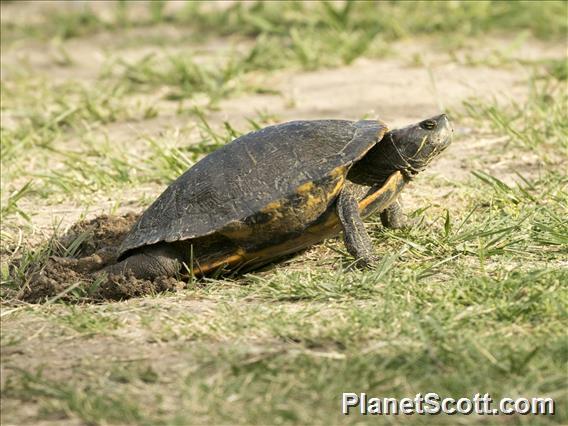Red-eared Slider (Trachemys scripta)






About Red-eared Slider (Trachemys scripta)
- Kingdom: Animals
- Phylum: Chordates
- Class: Reptiles
- Order: Turtles
- Family: Fresh Water Turtle
The pond slider is a species of common, medium-sized, semiaquatic turtle. Three subspecies are described, the most recognizable of which is the red-eared slider, which is popular in the pet trade and has been introduced to other parts of the world by people releasing it to the wild. Hatchling and juvenile pond sliders have a green upper shell (carapace), yellow bottom shell (plastron), and green and yellow stripes and markings on their skin. These patterns and colors in the skin and shell fade with age until the carapace is a muted olive green to brown and the plastron is a dull yellow or darker. Some sliders become almost black with few visible markings.
The carapace is oval with a bit of rounding and a central crest with knobs, but these features soften and fade with age, adults being smoother and flatter. For determining an adult slider's sex, males typically have much longer front claws than adult females, while females usually have shorter, more slender tails than males. Their lifespans range from 20 to 50 years.
Source: Wikipedia
Trips
Visits
-
2007-03-06
Lake Merced , United States of America -
2009-07-13
Victoria Peak, Hong Kong -
2012-09-30
Golden Gate Park - Stow Lake, United States of America -
2013-04-17
Matagorda County Birding Nature Center, United States of America -
2014-01-24
Santo Domingo - Botanical Gardens, Dominican Republic -
2014-03-15
Alemany Community Garden, United States of AmericaYellow ear. -
2016-02-22
Singapore Botanic Gardens, Singapore -
2021-11-19
Buenos Aires Reserva Costeneras, Argentina -
2021-12-12
Buenos Aires Reserva Costeneras, Argentina -
2024-02-17
Nezu Shrine, Japan -
2024-02-22
Naha Triangular Pond, Japan -
2024-09-04
Pasir Ris Park, Singapore




